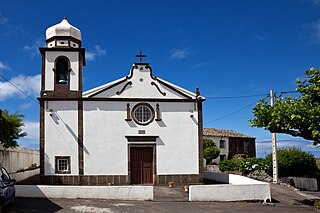
The Church of Nossa Senhora da Conceição is a church in the civil parish of Madalena, in the municipality of Lisbon.

The Church of Cedofeita is a medieval church in the civil parish of Cedofeita, municipality of Porto, in the northern Grande Porto Subregion of Portugal. The Church is a rare architectural example of a single-nave vaulted-ceiling temple, and the only one in the traditional Entre-Douro-e-Minho Province region of Portugal. It is classified as a National Monument.

The Church of São Lourenço is a Church in the civil parish of Almancil, in the municipality of Loulé in the Portuguese Algarve.
The Church of the Miserícordia de Valadares, or Church of Mercy/Charity of Valadares, is a 17th–18th-century Portuguese church located in the civil parish of Valadares, municipality of Monção in continental Portugal. The church was classified as Property of Public Interest in 1961.

The Church of São Miguel do Castelo is a medieval church in the civil parish of Oliveira do Castelo, municipality of Guimarães, in the northern district of Braga of Portugal. The church is emblematically linked to the foundation of the Portuguese Kingdom. Legend suggests that it was the sight of the baptism of the young Afonso Henriques. These claims are contradictory, since the date of the church's founding has been suggested to be during the reign of Afonso II of Portugal.

The Church of São Pedro de Rubiães is a 12th-century Romanesque church located in the civil parish of Rubiães in the municipality of Paredes de Coura, that was part of the medieval Way of St. James, the famous pilgrimage road to Santiago de Campostela. Over time it was expanded in the 16th and 17th century to become the parochial church of Rubiães. The Church was classified as National Monument in 1913.
The Church of the Lóios is a 15th church civil parish of Évora, municipality of Évora, in the Portuguese Alentejo.

The Church of São Mateus is a Baroque church in the civil parish of São Mateus da Calheta, in the municipality of Angra do Heroísmo, in the Portuguese archipelago of the Azores. The church is the major rural temple on the island of Terceira, and one of the larger churches in the Azores. Apart from its apparent volume, the church is marked by several carvings on its main facade, that include the three of the Cardinal Virtues, while its two lateral bell towers are unique in the archipelago for their size and pyramidal spires.

The Church of Porto Covo is Baroque and Neoclassic church in the civil parish, municipality of Sines, in the Atlantic coast of the Portuguese Alentejo. The church's austere lines is a morphological hybridization of the styles employed during the reign of Queen Maria I. In the widespread typology of regional architecture, the Baroque elements are evident in the lintels and trim curves, framed in a composition that is, generally, more rigid then in the gable design.

The Hermitage of Restelo, alternately Chapel of Saint Jerome, is a hermitage in the civil parish of Santa Maria de Belém, in the municipality of Lisbon. The religious architecture has Manueline and revivalist Neo-manueline elements, consisting of a single-nave structure with a vaulted ceiling and surrounded by a modernist landscape, as evidenced by a preoccupation with choice of plants and manicured environment, in order to create a zone of protection for the hermitage.

The Church of Nossa Senhora do Bom Despacho is the parochial church of the civil parish of Almagreira, located in the municipality of Vila do Porto, Portuguese archipelago of the Azores. It is a church of masonry, plastered and painted, constructed with decorative pilasters, friezes and cornices, molds and corner pinnacles, with a carved retable and tile covering.
The Church of São Salvador is a church in the civil parish of Trofa, Segadães e Lamas do Vouga, in the municipality of Águeda, in the Portuguese Centro district of Aveiro.

The Church of São Luís is a Latin Catholic Baroque church and former cathedral in the civil parish of Pinhel, in the municipality of the same name, Portuguese district of Guarda.

The Former Cathedral of Idanha-a-Velha is the decommissioned medieval Catholic cathedral of the former bishopric of Egitânia, in the Freguesia of Monsanto e Idanha-a-Velha, in the municipality of Idanha-a-Nova, in the central Portuguese district of Castelo Branco.

The Church of Santíssima Trindade is an 18th-century church located in the freguesia of Mosteiro in the municipality of Lajes das Flores, on the Portuguese island of Flores, in the archipelago of the Azores.

The Church of Nossa Senhora dos Remédios is an 18th-century church located in the civil parish of Fajãzinha in the municipality of Lajes das Flores, in the Portuguese island of Flores, in the archipelago of the Azores.
The Church of Santíssima Trindade is an 18th-century church located in the civil parish of Fazenda in the municipality of Lajes das Flores, in the Portuguese island of Flores, in the archipelago of the Azores.
The Church of São Caetano is a 17th-century church located in the civil parish of Lomba in the municipality of Lajes das Flores, in the Portuguese island of Flores, in the archipelago of the Azores.
The Church of São Pedro is a 17th-century church located in the civil parish of Ponta Delgada in the municipality of Santa Cruz das Flores, in the Portuguese island of Flores, in the archipelago of the Azores.

The Church of Nossa Senhora da Conceição is an 18th-century church located in the civil parish of Santa Cruz in the municipality of Santa Cruz das Flores, in the Portuguese island of Flores, in the archipelago of the Azores.

















